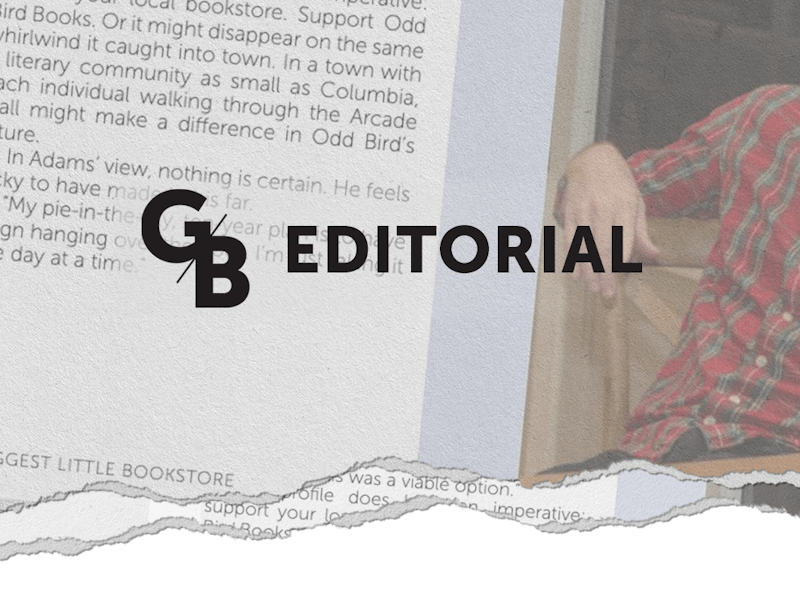Photo by Mark Maddaloni
It is the third most used language in the United States. It has its own grammar structure, vocabulary, unique culture and history. It has its own idioms, poetry, dialects and slang. Many universities and public schools these days recognize American Sign Language as a foreign language, but not yet the state or University of South Carolina. Why is this?
Many people – especially those who can hear – might reach the easy conclusion: Well, ASL isn't foreign, it’s American. This might seem simple enough to accept if you haven't spent time studying the language or meeting the community.
The Google definition of “foreign” is “of, from, in, or characteristic of a country or language other than one’s own.” By definition, ASL would already meet this requirement, being a different language from English.
But to break it down more: American Sign Language (ASL) is a visual/gestural language rather than an aural/oral one, but that doesn’t mean it is lacking in complexity, grammar and/or culture. There are hundreds of naturally occurring signed languages throughout the world, although this one is distinct to America and Canada. It is derived from French Sign Language, and therefore much more similar to FSL than it is to British Sign Language.
Kate Karpus, a third-year sociology student, first began learning ASL as a homeschooled high-schooler, where it counted as an elective.
When she saw it was offered at the university, she wanted to continue her studies, but had trouble fitting it into her schedule. Because it doesn’t fulfill any requirement, she had to wait until more space opened up in her schedule to fit it in. USC only offers one section per semester, offered through the night school as opposed to the Department of Languages and Literatures. The class caps at 22 students and fills up almost immediately as registration opens each semester.
Full disclosure: I was in this same situation, and I had to wait until my second-to-last semester of college to get into the ASL class. Karpus had to get an administrator to override the class cap in order for her to get in.
It was this process of registration as well as conversations with our professor, Andrea Martinez-Johnson, and people in the deaf community, that inspired Karpus to take up advocating for ASL to be counted as a foreign language at USC. While Karpus, a hearing person, does not wish to be the spokesperson for a culture she does not directly belong to, she does want to bridge the gap and facilitate the conversations between the decision-makers and the deaf community. From there, she hopes that the deaf community will be able to speak up for themselves and have their input respected. As a student at the university and a student of ASL, she felt she was in a unique position to advocate for the cause.
“I’ve talked to lots of people in lots of different departments, and they’ve all kind of given me different reasons for why it doesn’t count, which is interesting, because then I'll tell other departments what the initial departments have told me and they’re like, ‘No, that’s not the reason.’” Karpus said. “The first lady I talked to said it didn’t count because it was English – very not true. ASL is completely different in sentence structure. It’s actually based on French, so that was something I was trying to work through with her.”
There are forms of signing that are a direct translation of English, such as Signed Exact English and Pidgin Signed Language. However, these are not taught at USC; ASL is.
“[The administrator’s] exact words were, ‘It doesn’t count because it’s English.’ And my immediate thought was: I’m going to go in there and sign something, and since it’s English, you should be able to understand it,” Karpus said.
Currently there are at least 196 colleges and universities that offer or accept ASL for a foreign language credit. Within South Carolina alone, Anderson University, Clemson University, Converse College, North Greenville College and USC Upstate all offer ASL as a foreign language.
Clemson University also participates in a program that helps deaf students transition and settle into college with ease, and they provide a minor and interpreter program for ASL.
“There is a high probability that social workers, psychologists, nurses, doctors and others in the helping profession will encounter a deaf client or patient in their work. It would stand to reason that USC should offer it, same as most major universities,” Sherry Williams said. Williams is the president of the SC Association of the Deaf and an ASL teacher at Converse and Spartanburg Community College.
After having several run-around conversations, Karpus was directed to the Department of Languages and Literatures – the department that would actually have to adopt ASL before it could be considered as a foreign language credit or Carolina Core requirement.
Because of Karpus’ proposal, the department is currently considering adopting ASL – although no promises have been made at this time. While the department declined to give an official comment, they did say that conversations are being had within the department and that the idea is being taken seriously. However, such processes are slow-moving.
“I understand it’s a complicated process – I think,” Karpus said. “But it doesn’t seem like it should be incredibly complex in the way that they’re saying it should be.”
One counterpoint Karpus received from the department was that the purpose of the Carolina Core foreign language requirement was to get students studying abroad, going into other cultures and gaining new perspectives.
“Deaf people do have culture. And it is signed in US and Canada, so it’s not a universal language, but he was saying it was because you couldn’t travel to it. Which you can. You can immerse yourself in deaf culture. They have communities, and they do things together,” Karpus said.
Andrea Martinez-Johnson is the current ASL teacher at USC, employed through the night school. She is a graduate of Gallaudet University, the first deaf and hard-of-hearing university in the world. She is currently also a Certified Deaf Interpreter (CDI), a teacher aide with Richland One, and the treasurer of the South Carolina Association of the Deaf.
“In the fall of 2004, I started teaching the ASL class and it was very popular,” Johnson said. “I believe that ASL should [count] as a foreign language credit. My former ASL students did make an effort to get petitions about ASL. No luck.”
At the time, Johnson was told that Spanish language interpreters were in higher demand.
“However, in the deaf community, we need more interpreters,” Johnson said. “We have a lot of deaf people use the interpreters for work, going to the doctor, interviews and more. We need the program to be setting [students] up for the Interpreter Program.”
Karpus currently plans to continue her ASL education and eventually become a certified interpreter on the side.
“It’s the third largest language in the country and a lot of hearing people don’t know it, because there’s no incentive for them to know it,” Karpus said. “My incentive was more of – I have friends who are deaf, I’ve been working with people who are deaf, I just wanted to know it so I could communicate better with them.”
Offering ASL as a foreign language credit isn’t just about recognition; it’s about providing an incentive and opportunity for the students who want to take it. Karpus argues that it also an important aspect of embracing the deaf community.
“To me, it’s also about diversity and inclusion. So, this university obviously pushes that pretty hard, and yet there’s this entire people group that we’re just excluding,” Karpus said.
And it benefits not only hearing students, the deaf community and the university, but also prospective employers and employees.
“As for me, I have been teaching ASL for almost 20 years, mostly at the college level. I think it's a good idea for colleges to offer four semesters of ASL, to give the students a good basic foundation that they can use in their careers to communicate with their customers, clients, or patients,” Williams said.
“To me, it just doesn’t hurt anybody. I don’t understand why you would keep blocking it, because it doesn’t do any harm. It’s good to know ASL in any line of work; not only is it beneficial for the deaf community, but it also helps you get paid more, because if you know ASL, they don’t have to hire interpreters. If you’re certified, they don’t have to bring other people in and pay for them, because deaf people don’t pay for interpreters,” Karpus said. “So it just seems like more of a hassle to keep it down than it does to let it play out and become a credit. Because right now they’re paying somebody for a class that doesn’t count. This is something people want to do and it’s something people like. And you’re not going to give kids an opportunity to do it? It just doesn’t make any sense.”
On the first day of our first semester of ASL, one of the first things Johnson did was put on a YouTube video of deaf people signing along to “Waiting on the World to Change” by John Mayer. To me, the message was clear, and perfectly captured in this video and popular song; while they have never wanted or needed the affirmation of hearing people to be unapologetically themselves, they are still waiting for the change that they’ve wanted from the start. They’re not changing for the hearing world; they’re waiting for the hearing world to change.

